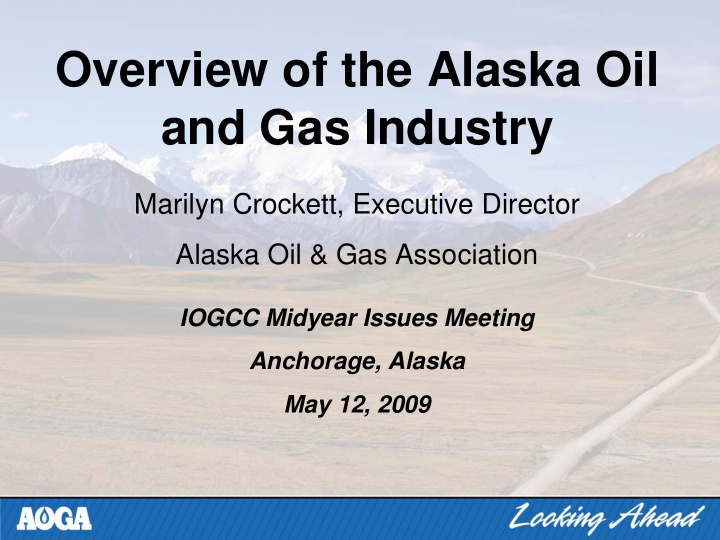



Overview of the Alaska Oil and Gas Industry Marilyn Crockett, Executive Director Alaska Oil & Gas Association IOGCC Midyear Issues Meeting Anchorage, Alaska May 12, 2009
AOGA Member Companies
Alaska’s Oil and Gas Industry • Where we are • What it means to Alaska and its Residents • How we do it • Where we’re going
Alaska Production • Oil production peaked in FY 1988 at 2 million barrels per day (bpd). • Production has declined 38% in the last 10 years. Source: Department of Revenue
Future Revenue Outlook “Oil revenues continue to dominate the unrestricted revenue picture – and is projected to provide more than 84% of General Purpose Unrestricted Revenue through FY 2018.” - Department of Revenue Revenue Sources Book Fall 2008
FY 08 Petroleum Revenue Royalty $ 3,219.7MM Production Tax $ 6,879.0MM Property Tax $ 358.0MM Corporate Income Tax $ 605.8MM Other $ 443.5MM TOTAL $ 11,506.0MM Royalty includes Permanent Fund contribution ($782.6MM) and School Fund contribution ($16.5MM). Property tax figure (also known as ad valorem) includes local government shares ($276.5MM). Other includes restricted revenues from NPR-A and tax settlements. Total (minus Permanent Fund, School Fund, local property tax, and other) represents 93% of unrestricted revenue.
50 Years of Petroleum Revenue TOTAL: $96 Billion (Restricted & Unrestricted) Royalties: $42 billion (50%) Production Tax: $34 billion (35%) Other: $20 billion (15%) Petroleum Revenue has constituted 83% of the state’s unrestricted revenue since statehood.
Study Team • Information Insights – Fairbanks and Anchorage • McDowell Group – Juneau and Anchorage • Sponsors: AOGA & its member companies
Key Findings • 88 percent of state general fund revenues • $236 million in local property taxes • $28 million in charitable contributions • Significant in every region in study
Key Findings • 41,744 jobs in Alaska – 9.4 percent of all employment in the state – 12 percent of private sector employment • $2.4 billion payroll in Alaska – 11.2 percent of all wages – 21 percent of private sector wages
How we do it: the Environmental Challenge
All of the oil and gas produced in Alaska… …is produced in sensitive environments
The Toolbox for Oil and Gas Development in Sensitive Areas in Arctic Alaska • Performance • 3-D Seismic Accountability • Extended Reach Drilling • Remote Sensing • Directional Drilling • Habitat Mapping • Horizontal Completions • Inter-Agency Cooperation • Wildlife and Fisheries • Coiled Tubing Studies • Rehabilitation • Roadless Development • Advanced Drilling Fluids • Predictable Permitting • Air Quality Monitoring Systems • Modular Drilling Rigs
The Toolbox for Oil and Gas Development in Sensitive Areas in Arctic Alaska (cont.) • Ice Roads and Ice Pads • Water Quality Baseline • Great Rocks Studies • Multilateral Completions • Good Community • Leak Detection Relationships Systems • Knowledgeable Agency Staff • Rolligons • Downhole Separation • A Little Luck Technology • Zero Tolerance for Incidental Damage from Seismic • Grind and Inject Technology
17 Putting the Toolbox to Work #
Winter Seismic Operations
Ice Road Access
Winter Drill Rig
The Follow ing Summer
Footprint Reductions through 1. 3D Seismic 2. Directional drilling 3. Extended Reach drilling 4. Horizontal completions 5. Well spacing
23 Directional Drilling #
Liberty Development Project: Background Offshore Development • Man-made gravel island with full production facilities • Buried pipeline to shore
Liberty Development Project: Background Existing Infrastructure • Use of SDI and MPI infrastructures • No construction of onshore well pads, roads, bridges, pipeline • Reduction of offshore and onshore environmental impacts
Liberty uERD Perspective: 8- Mile Departure
Baseline Studies • Water quality and volume in lakes proposed for water sources • Fish species present in lakes, streams and rivers • Hydrology studies • Habitat mapping for purpose of staging spill response equipment • Caribou studies • Subsistence surveys • Archaeological/cultural surveys • Bird nesting and brood rearing surveys (numerous bird species) • Vegetation studies • Evaluation of presence of threatened or endangered species
Examples of Long-term Monitoring Studies • Vegetation and Active Layer Studies (Vlad Romanovsky) • Tundra Nesting Birds • Snow Geese, Brant and Ravens • Foxes • Nearshore Fish Studies • Grizzly Bear Studies • Polar Bear Studies • Ringed Seal Counts from North Star
Polar Bears Protected by the Marine Mammal Protection Act (MMPA) of 1972 Protected by the ESA as threatened since May 15, 2008 Industry can petition the USFWS for Letters of Authorizations for Incidental Takes and Authorizations for Deterrence Activities under the MMPA
Mitigation Steps to Avoid Maternal Dens Activities will not operate or pass within 1 mile of a known polar bear den Female polar bears & cubs can not be deterred away from den sites Aerial or ground infrared surveys to identify dens Satellite tagging of female polar bears by USGS
Mitigation Measures Coordinated with USFWS Bear Deterrence Training Bear Behavior Deterrence Methods Bear Interaction Plan Protect Workers Bear Observers Food Waste Management Safety Devices Bear cages at Oooguruk Drillsite Bear Cages Skirting Monitoring/Video & Infrared Cameras
Industry Collaboration to Minimize Bear-Human Interactions Monitoring & reporting requirements Special training (by USFWS) for all personnel allowed to deter bears Coordinated Forward Looking Infrared (FLIR) Surveys to detect maternal polar bear dens
Aerial Forward Looking Infrared (FLIR) Surveys Larger landscape view Investigate den habitat along the coastline, barrier islands, river bluffs and any potential polar bear habitat Identify hot spots/heat signatures Star Safire III FLIR Unit Mapping and Video Screens Twin Otter
FLIR “Hot Spot” and Polar Bear Den Site
Ground FLIR Survey Hand held thermacam & range finder Video capabilities Using approved tundra travel vehicles Crew and Tucker Vehicle GPS mapping of routes Costs are lower for smaller areas
Production Forecast • In 10 years, the state forecasts 36% of total production will be new oil. • Even with this new oil, the state is forecasting a 20% reduction in total production in 10 years. Source: Department of Revenue
National Petroleum Reserve-Alaska
Beaufort Sea
Chukchi Sea
Recommend
More recommend